HR Compensation Report: Dell's Strategy, Compensation, and Alignment
VerifiedAdded on 2022/08/21
|5
|815
|23
Report
AI Summary
This report examines Dell's business strategy, SWOT analysis, and current market position. It explores how Dell uses compensation to achieve and sustain a competitive advantage, focusing on its performance management system. The report evaluates Dell's pay strategy against the VRIO framework for sustained competitive advantage, and defines the importance of internal alignment in compensation policy. The analysis covers the components of internal alignment and discusses its usefulness in compensation plans. The report provides a comprehensive overview of Dell's approach to HR compensation, highlighting the key elements that contribute to its success in the marketplace. References are included to support the analysis and provide further insights into the topic.
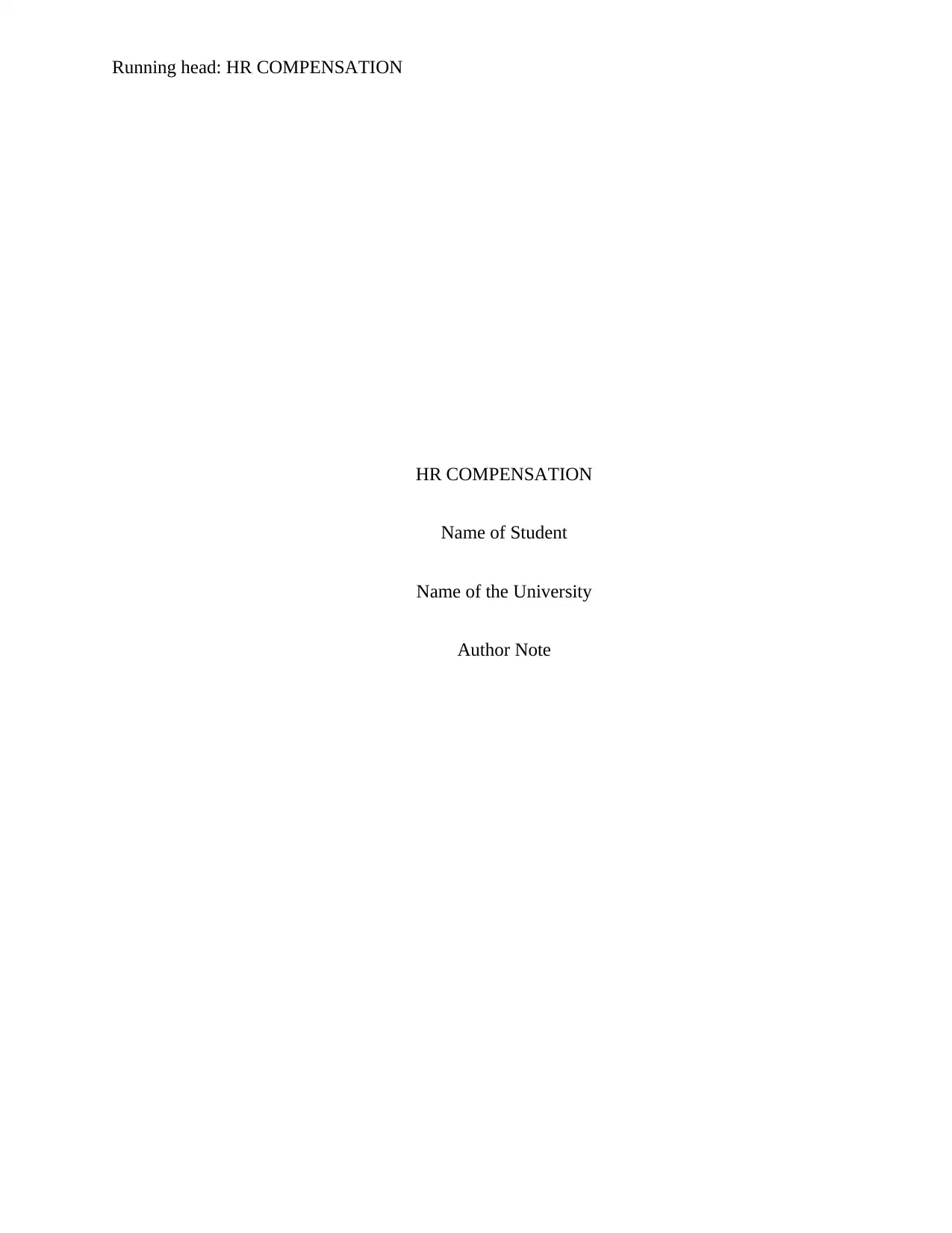
Running head: HR COMPENSATION
HR COMPENSATION
Name of Student
Name of the University
Author Note
HR COMPENSATION
Name of Student
Name of the University
Author Note
Paraphrase This Document
Need a fresh take? Get an instant paraphrase of this document with our AI Paraphraser
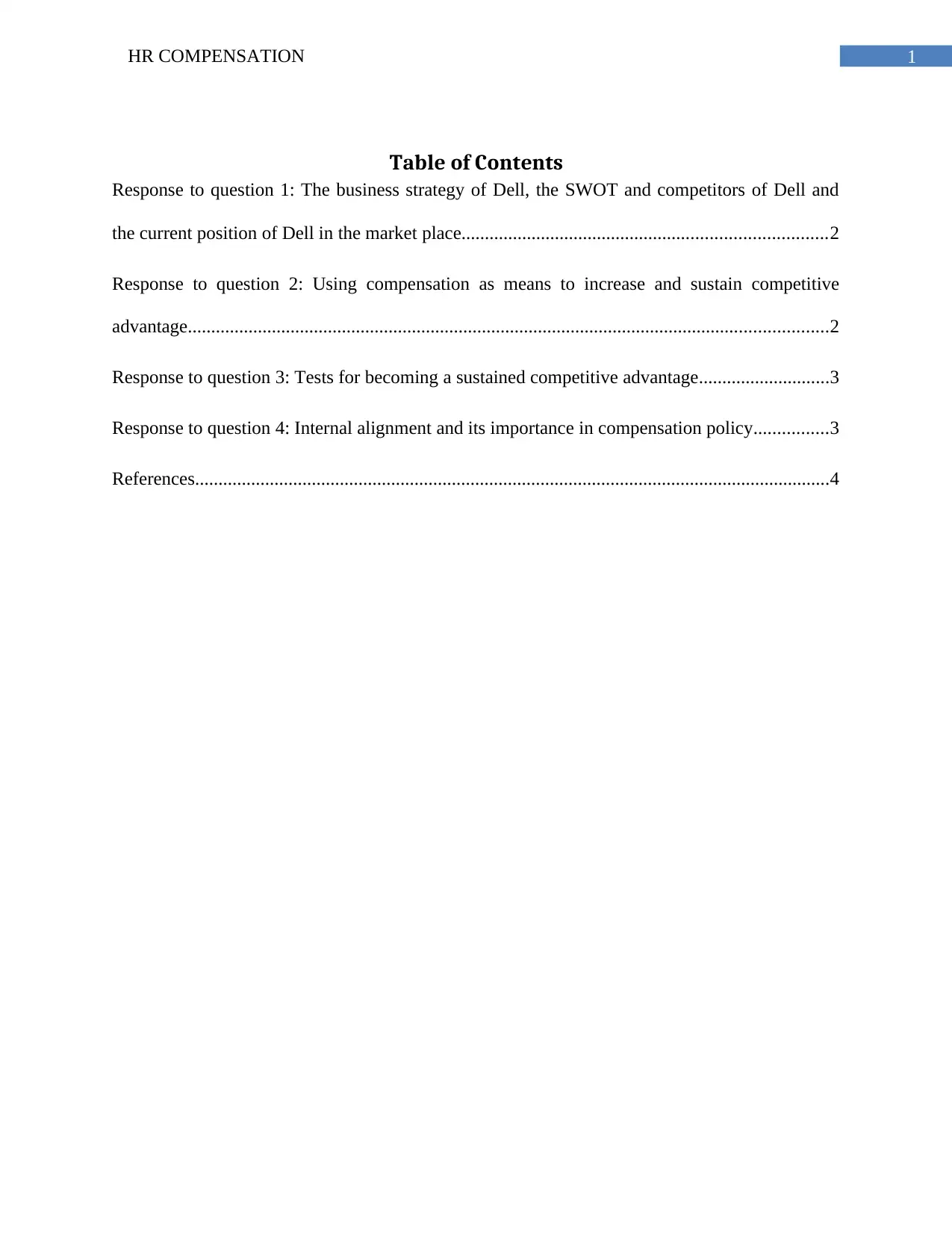
1HR COMPENSATION
Table of Contents
Response to question 1: The business strategy of Dell, the SWOT and competitors of Dell and
the current position of Dell in the market place..............................................................................2
Response to question 2: Using compensation as means to increase and sustain competitive
advantage.........................................................................................................................................2
Response to question 3: Tests for becoming a sustained competitive advantage............................3
Response to question 4: Internal alignment and its importance in compensation policy................3
References........................................................................................................................................4
Table of Contents
Response to question 1: The business strategy of Dell, the SWOT and competitors of Dell and
the current position of Dell in the market place..............................................................................2
Response to question 2: Using compensation as means to increase and sustain competitive
advantage.........................................................................................................................................2
Response to question 3: Tests for becoming a sustained competitive advantage............................3
Response to question 4: Internal alignment and its importance in compensation policy................3
References........................................................................................................................................4
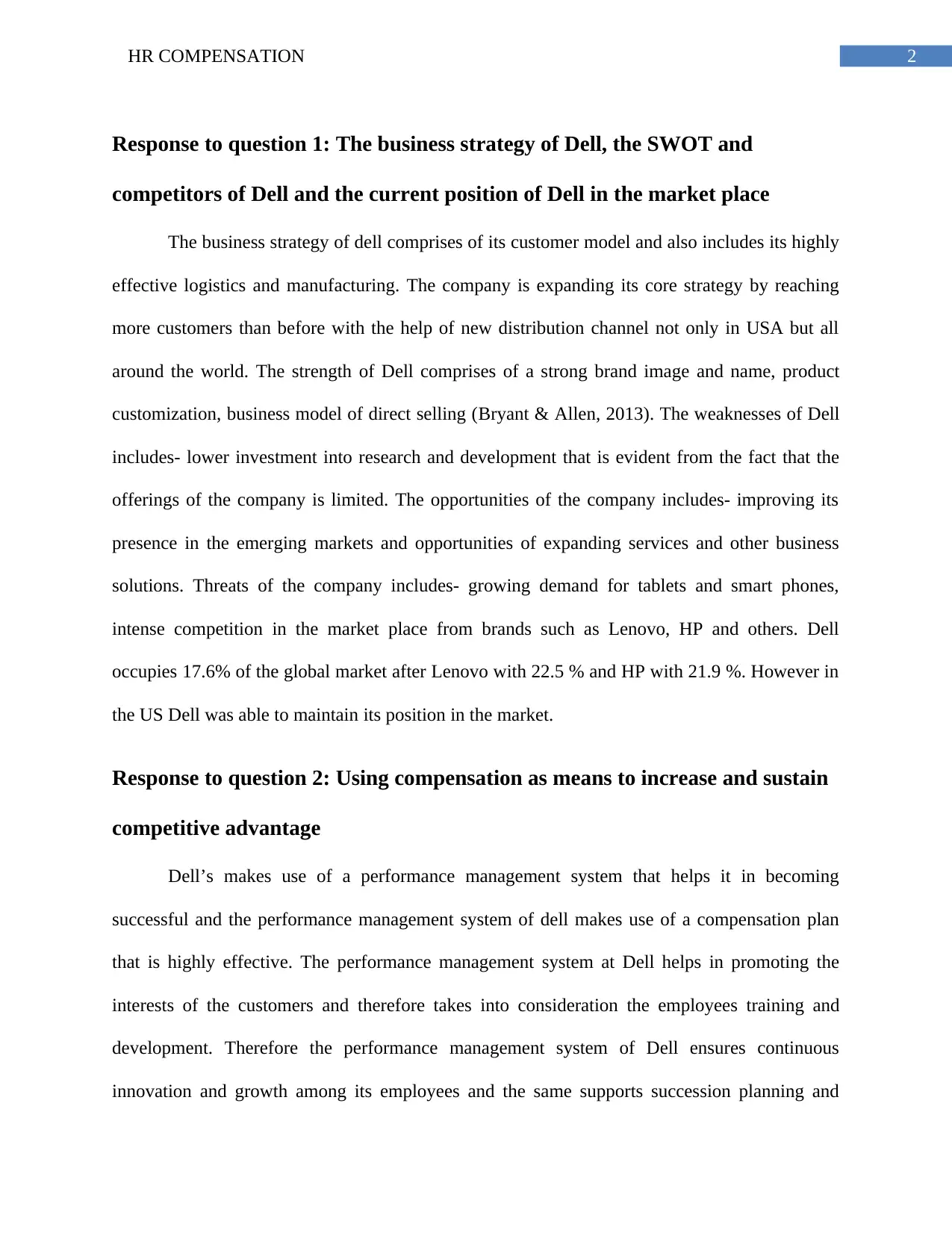
2HR COMPENSATION
Response to question 1: The business strategy of Dell, the SWOT and
competitors of Dell and the current position of Dell in the market place
The business strategy of dell comprises of its customer model and also includes its highly
effective logistics and manufacturing. The company is expanding its core strategy by reaching
more customers than before with the help of new distribution channel not only in USA but all
around the world. The strength of Dell comprises of a strong brand image and name, product
customization, business model of direct selling (Bryant & Allen, 2013). The weaknesses of Dell
includes- lower investment into research and development that is evident from the fact that the
offerings of the company is limited. The opportunities of the company includes- improving its
presence in the emerging markets and opportunities of expanding services and other business
solutions. Threats of the company includes- growing demand for tablets and smart phones,
intense competition in the market place from brands such as Lenovo, HP and others. Dell
occupies 17.6% of the global market after Lenovo with 22.5 % and HP with 21.9 %. However in
the US Dell was able to maintain its position in the market.
Response to question 2: Using compensation as means to increase and sustain
competitive advantage
Dell’s makes use of a performance management system that helps it in becoming
successful and the performance management system of dell makes use of a compensation plan
that is highly effective. The performance management system at Dell helps in promoting the
interests of the customers and therefore takes into consideration the employees training and
development. Therefore the performance management system of Dell ensures continuous
innovation and growth among its employees and the same supports succession planning and
Response to question 1: The business strategy of Dell, the SWOT and
competitors of Dell and the current position of Dell in the market place
The business strategy of dell comprises of its customer model and also includes its highly
effective logistics and manufacturing. The company is expanding its core strategy by reaching
more customers than before with the help of new distribution channel not only in USA but all
around the world. The strength of Dell comprises of a strong brand image and name, product
customization, business model of direct selling (Bryant & Allen, 2013). The weaknesses of Dell
includes- lower investment into research and development that is evident from the fact that the
offerings of the company is limited. The opportunities of the company includes- improving its
presence in the emerging markets and opportunities of expanding services and other business
solutions. Threats of the company includes- growing demand for tablets and smart phones,
intense competition in the market place from brands such as Lenovo, HP and others. Dell
occupies 17.6% of the global market after Lenovo with 22.5 % and HP with 21.9 %. However in
the US Dell was able to maintain its position in the market.
Response to question 2: Using compensation as means to increase and sustain
competitive advantage
Dell’s makes use of a performance management system that helps it in becoming
successful and the performance management system of dell makes use of a compensation plan
that is highly effective. The performance management system at Dell helps in promoting the
interests of the customers and therefore takes into consideration the employees training and
development. Therefore the performance management system of Dell ensures continuous
innovation and growth among its employees and the same supports succession planning and
⊘ This is a preview!⊘
Do you want full access?
Subscribe today to unlock all pages.

Trusted by 1+ million students worldwide
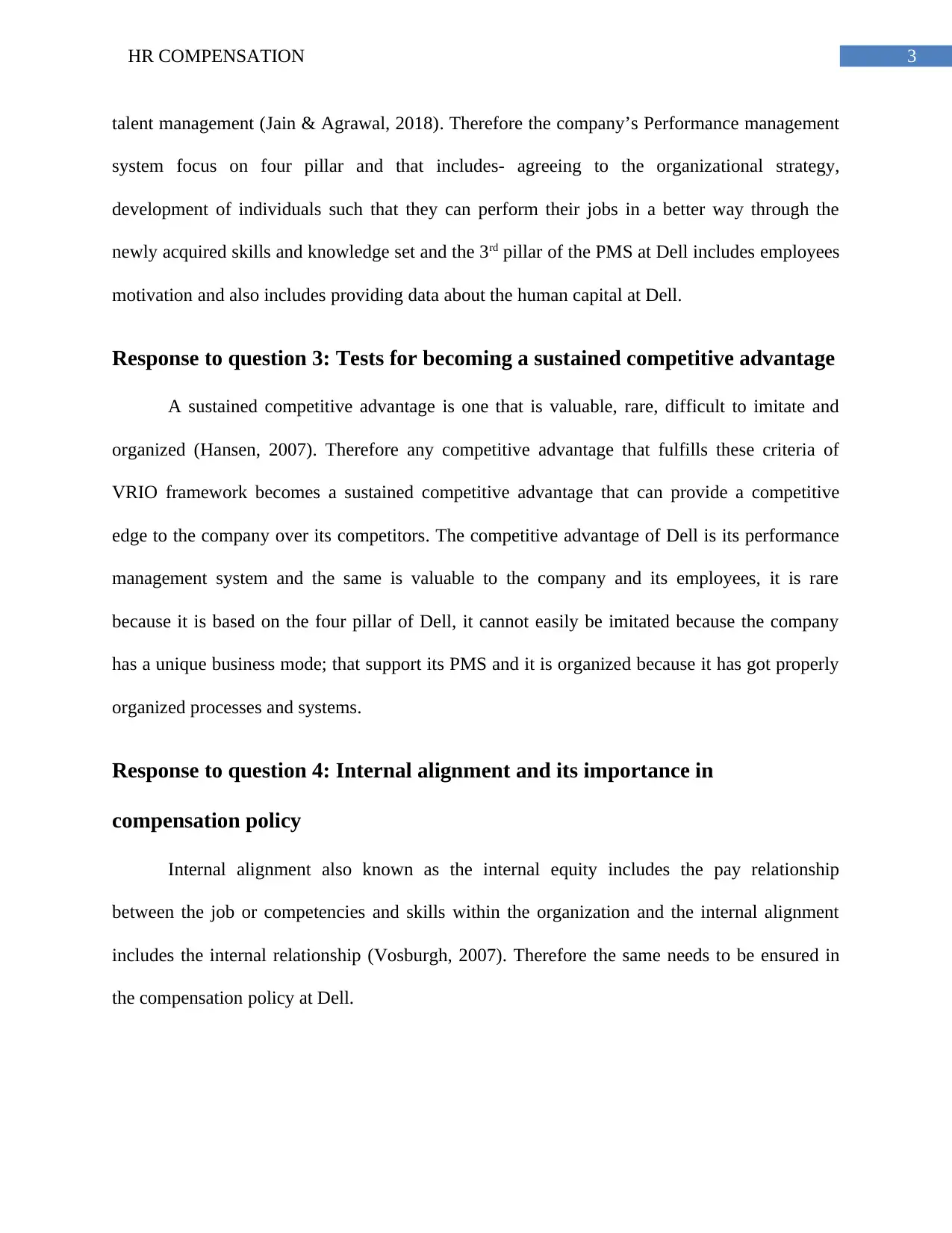
3HR COMPENSATION
talent management (Jain & Agrawal, 2018). Therefore the company’s Performance management
system focus on four pillar and that includes- agreeing to the organizational strategy,
development of individuals such that they can perform their jobs in a better way through the
newly acquired skills and knowledge set and the 3rd pillar of the PMS at Dell includes employees
motivation and also includes providing data about the human capital at Dell.
Response to question 3: Tests for becoming a sustained competitive advantage
A sustained competitive advantage is one that is valuable, rare, difficult to imitate and
organized (Hansen, 2007). Therefore any competitive advantage that fulfills these criteria of
VRIO framework becomes a sustained competitive advantage that can provide a competitive
edge to the company over its competitors. The competitive advantage of Dell is its performance
management system and the same is valuable to the company and its employees, it is rare
because it is based on the four pillar of Dell, it cannot easily be imitated because the company
has a unique business mode; that support its PMS and it is organized because it has got properly
organized processes and systems.
Response to question 4: Internal alignment and its importance in
compensation policy
Internal alignment also known as the internal equity includes the pay relationship
between the job or competencies and skills within the organization and the internal alignment
includes the internal relationship (Vosburgh, 2007). Therefore the same needs to be ensured in
the compensation policy at Dell.
talent management (Jain & Agrawal, 2018). Therefore the company’s Performance management
system focus on four pillar and that includes- agreeing to the organizational strategy,
development of individuals such that they can perform their jobs in a better way through the
newly acquired skills and knowledge set and the 3rd pillar of the PMS at Dell includes employees
motivation and also includes providing data about the human capital at Dell.
Response to question 3: Tests for becoming a sustained competitive advantage
A sustained competitive advantage is one that is valuable, rare, difficult to imitate and
organized (Hansen, 2007). Therefore any competitive advantage that fulfills these criteria of
VRIO framework becomes a sustained competitive advantage that can provide a competitive
edge to the company over its competitors. The competitive advantage of Dell is its performance
management system and the same is valuable to the company and its employees, it is rare
because it is based on the four pillar of Dell, it cannot easily be imitated because the company
has a unique business mode; that support its PMS and it is organized because it has got properly
organized processes and systems.
Response to question 4: Internal alignment and its importance in
compensation policy
Internal alignment also known as the internal equity includes the pay relationship
between the job or competencies and skills within the organization and the internal alignment
includes the internal relationship (Vosburgh, 2007). Therefore the same needs to be ensured in
the compensation policy at Dell.
Paraphrase This Document
Need a fresh take? Get an instant paraphrase of this document with our AI Paraphraser
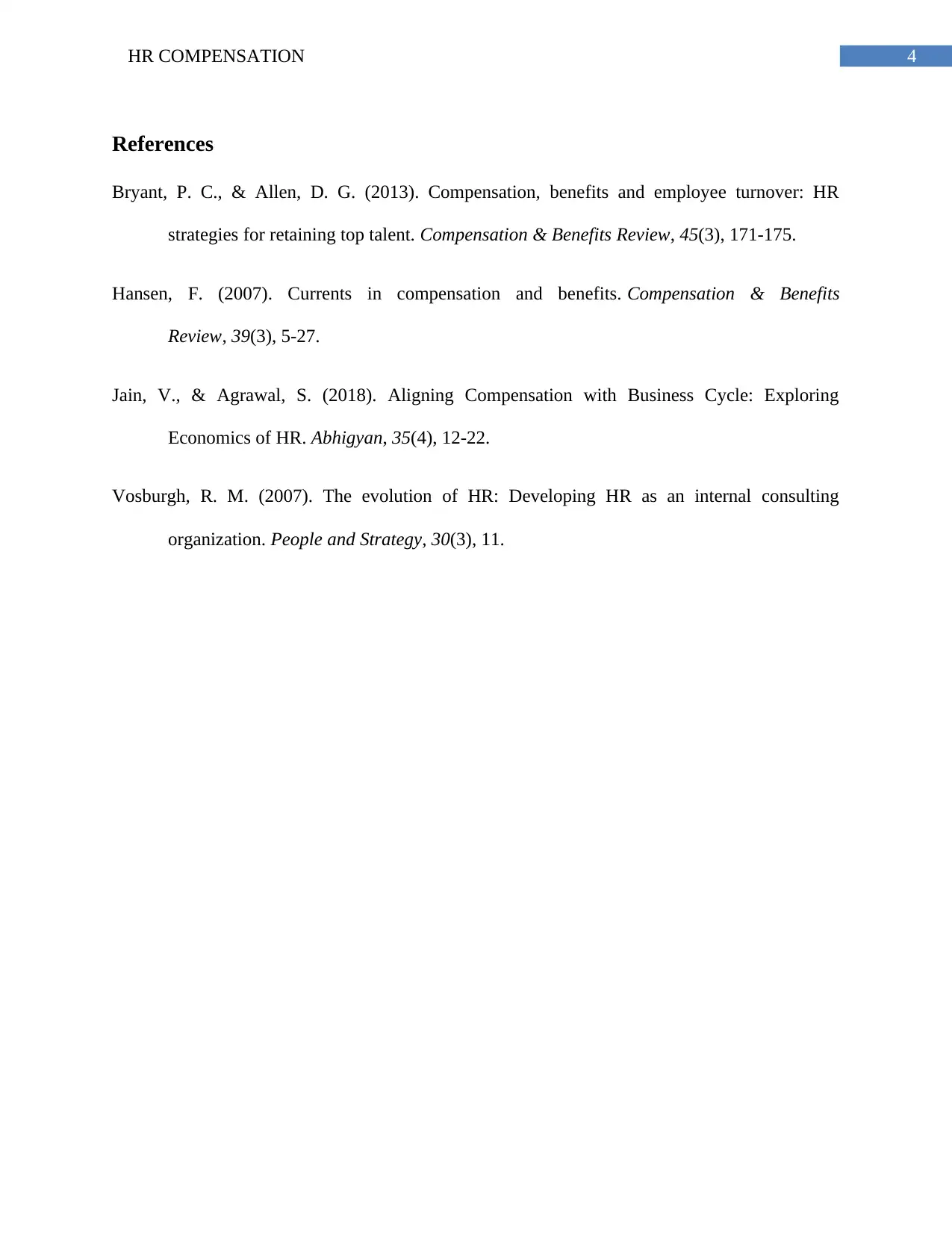
4HR COMPENSATION
References
Bryant, P. C., & Allen, D. G. (2013). Compensation, benefits and employee turnover: HR
strategies for retaining top talent. Compensation & Benefits Review, 45(3), 171-175.
Hansen, F. (2007). Currents in compensation and benefits. Compensation & Benefits
Review, 39(3), 5-27.
Jain, V., & Agrawal, S. (2018). Aligning Compensation with Business Cycle: Exploring
Economics of HR. Abhigyan, 35(4), 12-22.
Vosburgh, R. M. (2007). The evolution of HR: Developing HR as an internal consulting
organization. People and Strategy, 30(3), 11.
References
Bryant, P. C., & Allen, D. G. (2013). Compensation, benefits and employee turnover: HR
strategies for retaining top talent. Compensation & Benefits Review, 45(3), 171-175.
Hansen, F. (2007). Currents in compensation and benefits. Compensation & Benefits
Review, 39(3), 5-27.
Jain, V., & Agrawal, S. (2018). Aligning Compensation with Business Cycle: Exploring
Economics of HR. Abhigyan, 35(4), 12-22.
Vosburgh, R. M. (2007). The evolution of HR: Developing HR as an internal consulting
organization. People and Strategy, 30(3), 11.
1 out of 5
Related Documents
Your All-in-One AI-Powered Toolkit for Academic Success.
+13062052269
info@desklib.com
Available 24*7 on WhatsApp / Email
![[object Object]](/_next/static/media/star-bottom.7253800d.svg)
Unlock your academic potential
Copyright © 2020–2025 A2Z Services. All Rights Reserved. Developed and managed by ZUCOL.





